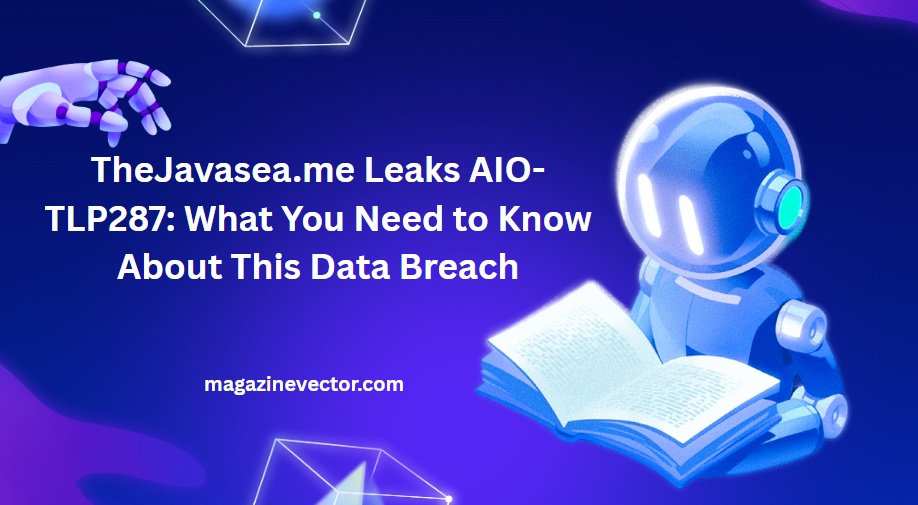In the digital era where data has become a currency and privacy a luxury, the rise of data breaches continues to be a disturbing trend. One of the most recent and concerning incidents to surface in underground communities and cybersecurity circles is the “TheJavasea.me leaks AIO-TLP287”. This leak has already started sending shockwaves across forums, data monitoring tools, and even enterprises—raising serious concerns about online privacy, credential security, and the growing sophistication of cyberattacks. Whether you’re an IT professional, a casual internet user, or a company storing sensitive customer data, understanding the scope and implications of the TheJavasea.me AIO-TLP287 breach is essential.
Table of Contents
What Is TheJavasea.me?
To understand the magnitude of the leak, it’s important to first understand what TheJavasea.me is and why it’s significant. TheJavasea.me is a well-known platform among data breach enthusiasts and cybercriminals that catalogues, compiles, and distributes stolen data. While it may not be as famous as major darknet marketplaces or data sharing sites like BreachForums (now defunct), TheJavasea.me has steadily grown a reputation for hosting leaked databases, compromised credentials, and sensitive user data from various online services and platforms.
The domain operates largely under the radar and uses obfuscation, rotating IP addresses, and sometimes anonymizing networks like Tor to avoid takedown attempts. It has become a hub for cybercriminals looking for combo lists (username and password combinations), email dumps, credit card leaks, and full databases. These resources are often used for credential stuffing attacks, phishing campaigns, and identity theft.
What Does “AIO-TLP287” Refer To?

The term AIO-TLP287 may sound cryptic at first glance, but it carries significant meaning in the underground cyber landscape.
- AIO stands for “All-In-One“, indicating that the data breach contains a comprehensive collection of information, often combining usernames, emails, passwords (hashed or plain text), phone numbers, and possibly payment data or IP addresses.
- TLP287 is believed to be a unique tag or identifier for this specific leak. In some cases, such labels help in organizing data batches or indicate the source or type of leak. It’s often used as a reference in hacking forums or Telegram leak channels to help users identify the data set being discussed.
This naming format mirrors those used in large-scale data breaches such as Collection #1–5, where multiple smaller breaches are compiled into massive single data dumps.
Scope and Size of the TheJavasea.me AIO-TLP287 Leak
Although official numbers are hard to verify, early reports and community discussions suggest that the AIO-TLP287 leak contains millions of records. These records are likely aggregated from multiple sources—meaning this breach isn’t just from one website or company but could involve dozens of smaller breaches compiled into one massive data set.
According to security researchers monitoring the dark web and data leak repositories, the following types of data were likely included in the AIO-TLP287 package:
- Full name
- Username
- Email address
- Plain-text or hashed passwords
- Phone numbers
- IP addresses
- Device metadata
- Location data
- Possibly payment details (depending on the origin of the breach)
In essence, it is an AIO (All-In-One) mega dump that can be weaponized for credential stuffing, phishing, and identity theft at scale.
How the Leak Came to Public Attention

Leaks like thejavasea.me aio-tlp287 don’t typically make mainstream headlines unless they affect a Fortune 500 company or millions of consumers. However, within cybersecurity and hacking forums, this data dump has been widely circulated since early 2025, often in encrypted formats or shared via Telegram, Discord, and private dark web channels.
Some red flags that raised attention included:
- Mentions of “TLP287” in dark web channels.
- Security researchers reporting abnormal spikes in credential stuffing attempts using emails from the dataset.
- Users discovering their data (emails, passwords) being used in unauthorized login attempts.
- Uploads of sample data files to pastebin-like platforms and code repositories as teasers.
The leak’s existence was eventually confirmed by data breach aggregators and cybersecurity companies who continuously crawl deep web forums and monitor malicious activity. Many are now warning that the leak could result in long-term consequences for both users and companies if not contained.
Who Is Affected by the TheJavasea.me Leak?
While it is difficult to pinpoint exactly who is affected, the general profile includes:
- Individuals using the same password across multiple accounts
- Users who signed up for websites with poor security protocols
- Customers of companies that suffered silent or unreported breaches
- Anyone whose data was scraped or obtained via phishing
Moreover, since the AIO-TLP287 appears to be an aggregated dump, victims may not even be aware that their data was compromised—especially if the original breach happened months or years ago and was never disclosed.
Real-World Impacts of the AIO-TLP287 Leak

Identity Theft and Account Takeovers
One of the biggest threats resulting from thejavasea.me leaks aio-tlp287 is identity theft. Cybercriminals often use these data sets to impersonate users, open fraudulent accounts, or gain access to other platforms using recycled credentials.
Credential Stuffing Attacks
Because many people reuse passwords, the email-password pairs from the AIO-TLP287 leak are likely being used in automated credential stuffing attacks. Bots run millions of login attempts using these leaked combos on platforms like Netflix, Amazon, Facebook, and banking apps.
Phishing Campaigns and Scams
With personal information like names, emails, and phone numbers exposed, attackers can launch targeted phishing campaigns that appear more legitimate. This often results in users clicking on malicious links or unknowingly handing over more sensitive data.
Reputation Damage for Companies
If a company’s user database is found to be part of this leak—even if indirectly—it could erode customer trust, invite legal scrutiny, and lead to regulatory fines under GDPR, CCPA, or other data protection laws.
How to Check if You Were Affected
While the AIO-TLP287 leak hasn’t been officially indexed in all public breach databases yet, there are still ways to protect yourself:
- Use websites like HaveIBeenPwned.com to check if your email appears in known breaches.
- Set up Google Alerts for your email or full name to catch unusual data usage.
- Check dark web monitoring services from companies like Norton, LifeLock, or Bitdefender.
- Be wary of phishing emails or login attempts you didn’t initiate.
What to Do If Your Data Was Leaked
If you suspect your credentials or personal data were part of the thejavasea.me leaks aio-tlp287, follow these steps:
1. Change Your Passwords Immediately
Start by updating passwords for your email accounts, banking apps, and social platforms. Use strong, unique passwords and avoid reusing the same one across platforms.
2. Enable Two-Factor Authentication (2FA)
Even if your credentials are leaked, 2FA provides an extra layer of protection. Enable it wherever possible—especially on email, financial accounts, and cloud services.
3. Monitor Your Financial Accounts
Look for suspicious activity in credit cards, PayPal, Venmo, and other financial accounts. If needed, contact your bank to freeze or issue new cards.
4. Use a Password Manager
Tools like LastPass, 1Password, or Bitwarden can help generate and store secure passwords, reducing the chance of falling victim to future breaches.
5. Report Identity Theft
If you notice any signs of identity theft, report it to local authorities and consumer protection agencies. You may also need to freeze your credit with bureaus like Experian, TransUnion, and Equifax.
How Companies Can Respond to the AIO-TLP287 Leak
For companies and web platforms, this breach is a reminder of the importance of proactive cybersecurity.
- Conduct internal audits to check if your data was exposed.
- Force password resets for potentially affected users.
- Implement rate-limiting and bot protection tools to defend against credential stuffing.
- Improve encryption protocols for storing passwords and sensitive data.
- Communicate transparently with users if your company is linked to any part of the leak.
Legal and Ethical Implications
Hosting or accessing sites like TheJavasea.me can be a legal gray area depending on your jurisdiction. Possession and distribution of stolen data is a crime in many countries, and visiting such platforms could place you under surveillance or investigation. Ethically, using leaked data—even for “research”—can have harmful consequences for real people.
Cybersecurity professionals should instead rely on ethical tools and resources and avoid engaging with criminal entities.
Final Thoughts
The TheJavasea.me Leaks AIO-TLP287 breach is a glaring example of the vulnerability of digital identities in today’s interconnected world. As hackers become more efficient and data marketplaces more organized, the need for personal security hygiene and corporate vigilance has never been greater. While it’s impossible to prevent all leaks, proactive measures—from strong passwords and 2FA to employee training and regulatory compliance—can reduce the risk and minimize the damage.
Staying informed, prepared, and alert is your best defense in this ever-evolving cyber landscape.
- Read More Blogs At Magazine Vector





